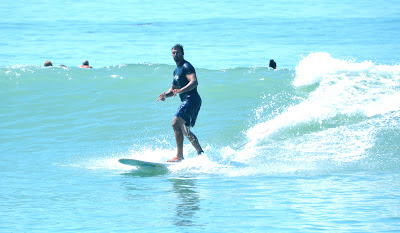A client inquired about my chapter on STARFISH in lieu of the Riley Cooper situation. If you haven't read
"The Surfer's Guide To Marketing" (and I can't possibly fathom why you haven't)
STARFISH is my term for celebrities involved in corporate relationships, endorsements, etc. We are currently discussing using professional athletes for a product placement campaign and the client brought up recent issues with Aaron Hernandez, Riley Cooper, A-Rod, and even Johnny "Heisman" Manziel. While I would never profess to be the celebrity expert to the extent of Super Agent Leigh Steinberg, whom we featured in
"The Surfer's Guide To Marketing," I do have significant experience in sourcing the right STARFISH personality to drive a company's awareness and messaging.
Recently, I wrote an in-depth post about a similar issue with Sergio Garcia and Tiger Woods so please feel free to read the post
here. But with this recent wave of stories making the news, it's difficult to avoid this discussion and as always, I tell clients to look at the individual and explore that specific STARFISH rather than just generalize. I tend to use retired players due to their experience and availability but every brand, every event, and every STARFISH requires individual attention to determine their viability as a representative for your brand.
Much like a GM of a pro football team, you need to do your homework. With someone like Riley Cooper (who recently made a racial slur that was caught on video) you could have probably gotten a feel for what kind of guy he is based on past record, his teammates, etc. When the video emerged, you can determine perhaps if it was an isolated incident or if perhaps he's not the best STARFISH to appear on the packaging of your product. Obviously, in the immediate future, he won't need to be answering many calls from potential sponsors, but in general, you can get a feel for how a STARFISH carries themselves and represents themselves as a brand before they represent your brand.
Serious controversies like Aaron Hernandez, OJ Simpson, or Rae Carruth are not the typical situation most STARFISH get involved with so if we eliminate extreme cases, we can better dissect the risks involved with celebrity endorsements. This offseason, there were reports about how over 30 NFL players were arrested since the Super Bowl and the world gasped! Such an astronomical rate, right? I would simply argue that these stats are not much different than that of the average 20 to 25 year old male. Young men make more mistakes than the population as a whole and ask any insurance agent which demographic takes the brunt of playing "the law of averages" when determining rates. While DUI, simple assault (bar fight), and other minor infractions are not acceptable under any circumstance, are NFL players dramatically worse than the average population in terms of most simple misdemeanors?
While someone like Johnny Manziel is obviously not eligible for securing endorsements as an amateur, would you be surprised that a 20-year-old famous guy in the social media age would have a few blips on the character radar? And let's be honest, his only "issues" involve maybe a few too many beers, sleeping in late, tweeting from sporting events, and going to a fraternity party. In my day, that would have made him pretty much
every other student in college not named Tim Tebow! But seeing his reaction (which may even be a little justified with all the media piling on) would make me hesitant to recommend him for corporate opportunity if that option was available today. I'm not defending any of the actions of players who end up in the news for the wrong reasons, but I just want to keep it in perspective.
Even when you do your homework, have worked with trusted STARFISH with impeccable reputations, or even have personal relationships, you might find yourself caught up in a celebrity's saga. It's great PR when your STARFISH does something wonderful on or off the field. After all, isn't that the purpose of even having the relationship? Win the Super Bowl, donate to a charity, take time to mentor children in their community... it is all golden. But even with a record of such service, it can all come into question when a player does something heinous... like leaving a $3 tip!
Obviously I'm being sarcastic when I bring up the Drew Brees "Tipgate" controversy. Drew is also featured in "
The Surfer's Guide To Marketing" and I highlight his community service and overall positive stance as a role model. But even a "sure fire" endorser of brands including Pepsi and Pampers can find himself mixed up in a debate and his recent $3 tip (on a takeout order that he picked up, BTW) is quintessential ESPN filler for the nine hours of debate shows they air ad nauseum. There is no controversy here and I would argue that Brees is one of the most courteous and generous STARFISH out there. Nonetheless, the Super Bowl MVP has been brought into a discussion that explores his character and doesn't revolve around touchdowns or completions!
So what's the solution? If you want to utilize STARFISH to drive your brand, you simply need to approach it like any other resource and do your homework.
"The Surfer's Guide To Marketing" explores step-by-step actions and suggestions you can take to ensure you make the best decisions possible and aside from simply creating your own mascot character for a spokesman, there will always be a variable of human error when dealing with humans!
Oh wait, didn't the AFLAC duck get fired for insensitive jokes?
























